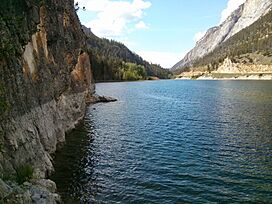Marble Canyon (British Columbia) facts for kids
Quick facts for kids Marble Canyon |
|
|---|---|
 |
|
| Lua error in Module:Location_map at line 416: Malformed coordinates value. | |
| Geography | |
| Country | Canada |
| Province | British Columbia |
| Regional district | Squamish-Lillooet and Thompson-Nicola |
Marble Canyon is a cool natural wonder in British Columbia, Canada. It's located in the south-central part of the province, not far from the Fraser River. You can find it about halfway between the towns of Lillooet and Cache Creek. This amazing canyon was formed when a type of rock called karst collapsed over time.
Contents
Why is it called Marble Canyon?
The canyon gets its name from the bright, shiny rock on its walls. This rock looks a lot like marble! However, it's actually a type of rock called limestone. Limestone is a sedimentary rock, which means it forms from layers of tiny bits of other rocks or shells. Real marble is a metamorphic rock, which means it's limestone that has been changed by heat and pressure deep underground.
The local Shuswap language has its own name for the canyon. The whole area is called sxmeltám. This name might refer to "Indian doctors" or traditional healers. A specific part of the canyon, near Crown and Turquoise Lakes, is called getsgátsp. No one is sure what this name means. You can also see a cool rock formation here called Chimney Rock. It's a tall, eroded pillar rising from the lake.
Exploring the Canyon's Geography
Marble Canyon has very tall walls. The north wall rises over 965 meters (about 3,166 feet) above Pavilion Lake. This is the southern edge of the Marble Range mountains. The south wall is about 515 meters (about 1,690 feet) high. This wall is the northern end of the Clear Range mountains. Even taller peaks are found behind these walls, making the canyon even deeper if measured from their tops.
Discovering Ancient Life: Stromatolites
Inside Marble Canyon, there are several lakes that flow into the Fraser River through Pavilion Creek. The biggest of these is Pavilion Lake. This lake is home to something very special: microbialites. These are also known as stromatolites. They are unusual structures built by tiny living things called bacteria. They look a bit like freshwater "coral." These are the largest freshwater stromatolites found anywhere in the world! They give us a peek into what early life on Earth might have looked like.
Adventure Time: Rock and Ice Climbing
Marble Canyon is a popular spot for people who love to climb. Its clean rock walls are great for rock climbing. In winter, it also becomes a fantastic place for ice climbing! One famous frozen waterfall, officially called Crown Lake Falls, is known to climbers as "Icy BC." It freezes solid in the middle of winter. This amazing ice climb is right across from the provincial park campground, which is next to Highway 99.
Cultural Importance of the Canyon
The areas within Marble Canyon, including Pavilion Lake, are not just a provincial park. They also have special cultural rights and deep spiritual meaning for the Pavilion Indian Band. This means the land is very important to their history and traditions.
See also
- Marble Canyon Provincial Park
- Marble Canyon 3 (Indian Reserve)
- Pavilion, British Columbia
- Pavilion Lake
- Hat Creek (British Columbia)
- Upper Hat Creek, British Columbia
- Upper Hat Creek 1 (Indian Reserve)
- Lower Hat Creek, British Columbia (Carquile/Hat Creek Ranch)
- Lower Hat Creek 2 (Indian Reserve)


